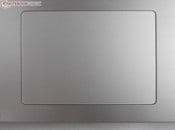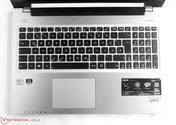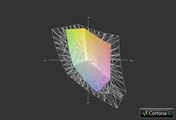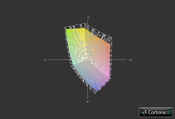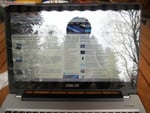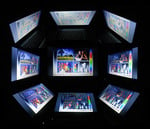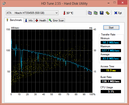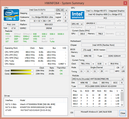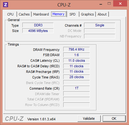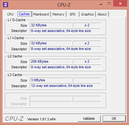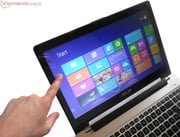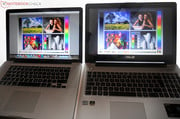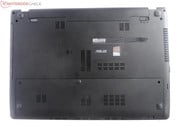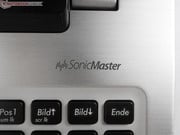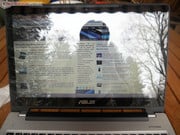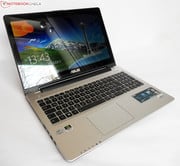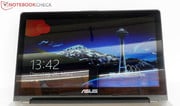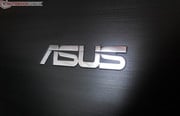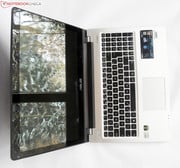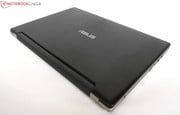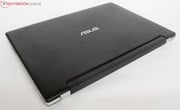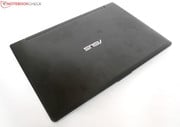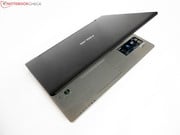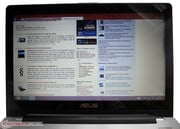华硕VivoBook S550CM CJ038H的Ultrabook测评

For the original German review, see here.
Swiping, zooming, rotating and tapping intuitively via the touch of a finger - this method of touch-sensitive use is surely not an awe-inspiring innovation seeing that we have been using touchscreens in our phones or tablets for years. After this wave in the form of convertibles has increasingly blurred the boundaries between tablet and laptop computer, Asus now also aims at the implementation of this operating concept in the laptop, or rather ultrabook sector via a 15.6-inch touchscreen in its new VivoBook S550CM-CJ038H.
Having tested the smaller S200E, S400CA and U38DT sister models, we are now taking a look at the new 15.6-inch VivoBook S550CM-CJ038H touch-ultrabook. Is it a superfluous try to follow the touchscreen hype or is really an added value for the laptop's use?
对于的德国原装审查,在这里看到。
刷卡,缩放,旋转和攻丝直观地通过手指触摸 - 触摸感应使用这种方法肯定是没有看到,我们一直在使用触摸屏手机或平板电脑多年的凛然创新。后可转换债券的形式在这波平板电脑和笔记本电脑之间的界限越来越模糊,华硕现在也旨在通过一个15.6英寸的触摸屏,在其新的VivoBook在笔记本电脑,而ultrabook的部门在执行此操作概念S550CM CJ038H。
S400CA和U38DT的的姊妹车型,经测试S200E较小,我们现在一起来看看新的15.6英寸的VivoBook S550CM CJ038H触摸的ultrabook。它是一个多余的尝试按照触摸屏炒作或笔记本电脑的使用是一个真正的附加值?
Case
Since the new Asus VivoBook S550CM-CJ038H is very similar to the S56CM ultrabook model in casing, workmanship and input devices, the impressions, advantages and shortcomings can largely be transferred onto our test device.
Like the S56CM, this ultrabook also features aluminum components. The black, brushed aluminum display lid and the silver, precious metal base unit make a high-end and robust impression and provide a pleasantly cool feel. Minor drawbacks are the quickly accumulated and very visible fingerprints. The quality impressions in terms of stability and workmanship can also be adopted. The base unit of the VivoBook strikes with high rigidness and barely yields anywhere even when greater force is applied.
In contrast to the S56CM's display lid, which was not a reason for concern but proved to lack some stiffness, the lid of the S550CM-CJ038H is quite rigid.
We also noticed the tightly pulled display hinges that stand out a bit, though evidently, from its sister model. This prevents opening the laptop with only one hand because the base unit lifts, but they keep the display firmly and tightly in position. This is definitely an advantage in our opinion.
Overall, the VivoBook S550CM-CJ038H presents a decent workmanship and quality impression particularly in view of the price range.
由于新华硕VivoBook S550CM CJ038H是非常相似的S56CM的ultrabook外壳,做工和输入设备模型的印象,优点和缺点,可以在很大程度上被转移到我们的测试设备。
本Ultrabook的像S56CM,还设有铝组成。黑,拉丝铝显示屏盖和白银,贵金属的基本单元,使一个高端和稳健的印象,并提供了一个凉爽的感觉。小缺点是快速积累和非常明显的指纹。还可以采用质量的稳定性和工艺方面的印象。 VivoBook高刚性罢工的基本单位,几乎没有产生任何地方,甚至更大的力,应用时。
对比的S56CM的显示屏盖,这不是一个值得关注的理由,但事实证明,缺少一些刚性的盖子S550CM CJ038H是相当严格的。
我们也注意到死死拉住显示脱颖而出位的铰链,但显然,从它的姐妹机型。这可以防止只用一只手打开笔记本电脑,因为基本单位升降机,但他们保持牢固和紧密的显示位置。在我们看来,这是绝对的优势。
总体而言,在的VivoBook S550CM-CJ038H提出一个体面的做工和质量的印象,特别是在的价格区间。
Connectivity
The connectivity can also almost completely be adopted from our previously tested sister model. Three USB ports (1x USB 3.0, 2x USB 2.0), an Ethernet (LAN) port, a headphone/microphone jack, a card reader, HDMI and VGA for multi-monitor use and the compulsory Kensington lock alongside an appreciated, yet rare in ultrabooks, DVD drive form the identical connectivity counterpart to the S56CM model.
Of course the same drawback results as noticed in the S56CM. Left-handed users will not find the situation ideal for use since the fan and the ports at the front are on the left.
连接也可以几乎完全采用我们先前测试的姊妹车型。 3个USB接口(1个USB3.0,2个USB 2.0),以太网(LAN)端口,耳机/麦克风插孔,读卡器,HDMI和VGA多显示器的使用和赞赏,但罕见的一起强制Kensington锁超极本,DVD驱动器相同的连接对应的S56CM模型。
当然,同样的缺点,结果注意到,在S56CM。左手用户将无法找到的情况下使用的理想选择,因为在前面风扇和端口在左侧。
Communication
The comparability of both notebooks continues in communication features, accessories and warranty. The S550CM-CJ038H communicates using a cabled option via an Ethernet port or wireless via a Wi-Fi module. The latter did a good job with full signal strength up to approx. 5 meters. The user also still has a very good connection to the wireless network with 4 of 5 bars even at higher distances of 10-15 meters. A Bluetooth interface for wireless data sharing finishes the communication bundle.
Accessories
Although the accessories for the 15.6-inch touch-ultrabook are sparse and only include the power supply unit, quick start guide and a few other information leaflets, it is sufficient. There is no recovery DVD.
Warranty
Asus includes the standard 24 month manufacturer warranty with pick-up & return service in some countries on its new touch-ultrabook ex-factory. The warranty can be upgraded to 3 years for approx. 75 Euros (~$97) via Asus' warranty upgrade package. More information about this topic can be found in our FAQ article "Warranty, Guarantee, and Right of Return" (German language).
沟通
两款笔记本的可比性继续在通信功能,配件和保修。该S550CM CJ038H通信通过一个Wi-Fi模块,通过以太网口或无线使用电缆选项。后者做了一个完整的信号强度高达约抓好。 5米。用户也仍然有一个很好的连接到无线网络,即使在较高的为10至15米的距离45巴。蓝牙接口,无线数据共享完成通信包。
饰品
虽然15.6英寸的触摸式Ultrabook的配件是稀疏的,只包括电源供应器,快速入门指南和其他一些资料单张,就足够了。有没有恢复DVD。
保
华硕回升退换货服务在一些国家在其新的触摸ultrabook的出厂价包括标准的24个月的制造商保修。保修期也可升级至3年的约。 75欧元(约$97)通过华硕的保修升级包。有关此主题的更多信息,可以发现在我们的常见问题的文章“保证,担保,回归权”(德语)。
Input Devices
Keyboard
The manufacturer does not experiment with the keyboard either. Thus, a typical chiclet keyboard alongside a number pad is used in the VivoBook S550CM-CJ038H. Like in the S56CM, it also did a perfect and flawless job in our test device, although the keys feature a fairly thin and not very high-quality feel. The typing feel exhibited a short drop and soft but satisfactorily firm stroke is on category average and will likely appeal to most users.
Touchpad
The generously sized touchpad of 10.5 x 7.5 cm appeals with its very good gliding traits and allows using the ultrabook comfortably. "Blind" use proved to be problematic because there are no dedicated mouse keys. Consequently, the finger will often stray too far left or right due to the lack of palpable zones and incorrect inputs are inevitable. However, this is a general problem of touchpads lacking dedicated mouse keys.
A much bigger nuisance results from the mouse replacement's interaction with Windows 8. We experienced innumerable unintentional inputs in the test because unintentional swiping changes the "classic" Windows view to the "Metro" (tile) interface. Thus, using the touchpad without looking is only possible to a very limited degree. However, it is generally possible to work well with the touchpad although an external mouse would certainly be recommendable for more reliable and less error-prone inputs.
Touchscreen
The third input device and the most striking feature of the VivoBook S550CM-CJ038H is the touch-sensitive screen that adds another control dimension to the ultrabook.
This seems to make sense alongside Windows 8 whose tile interface is just designed and optimized for touch gestures. However, the technology does not always exploit its advantages in practice. The user will move on to the classic Windows desktop most of the time which is not optimized for finger gestures. This results in regular unintentional inputs. Ultimately, there is no real productive gain or added value in the operation of the ultrabook in everyday use. Technically, the screen makes a good impression due to fast and short response times and a quite accurate detection of the various multi-touch gestures.
键盘
制造商不尝试用键盘。因此,沿着一个数字键盘,一个典型的巧克力键盘是用来在在的VivoBook S550CM-CJ038H。像在S56CM中,它也做了一个完美无瑕的工作在我们的测试设备,虽然键配备了相当薄的,而不是非常高品质的感觉。打字的感觉呈现短降和软但令人满意坚定中风类平均,可能会吸引到大部分用户。
触摸板
宽敞的触摸板10.5 x 7.5厘米上诉很好的滑翔性状和允许使用Ultrabook的舒适。 “盲”的使用被证明是有问题的,因为没有专用的鼠标键。因此,手指常常会偏离太远向左或向右由于缺乏扪区和不正确的输入,是不可避免的。然而,这是一个普遍的问题,触摸板,没有专用鼠标键的。
一个更大的滋扰结果与Windows 8从鼠标替代的作用。我们经历了无数无意在测试输入,因为无意刷卡改变了“经典”的Windows查看“地铁”(瓦)接口。因此,不看使用触控板是唯一可能在非常有限的程度。但是,它是一般的工作以及与外接鼠标的触摸板虽然肯定会推荐更可靠,更不易出错输入。
触摸屏
第三个输入设备和最突出的特点VivoBook S550CM CJ038H的是触摸屏,又增加了控制层面的ultrabook。
这旁边的Windows 8的瓷砖接口设计和优化的触摸手势似乎是有道理的。然而,该技术并不总是在实践中发挥自身优势。用户将移动到经典的Windows桌面上大部分时间没有手指的手势进行了优化。这样的结果经常无意投入。最终,在日常使用中的ultrabook的操作中没有真正的生产收益或附加值。技术上,画面给人留下好印象,因为快而短的响应时间和相当准确检测各种多点触摸手势。
Display
A 15.6-inch screen is installed in Asus' VivoBook S550CM-CJ038H. Besides the highlight of this ultrabook model, namely its touchscreen feature, the user regrettably only gets standard fare.
The glare-type screen in edge-to-edge design only has a resolution of 1366x768 pixels. It is based on an average TN screen whose rates do not break any records. An average maximum brightness of just below 200 cd/m² and a weak contrast of 171:1 result in a low-contrast image. The modest black value of 1.26 cd/m² causes a very dark-gray black reproduction. The content also looks a bit pale in general. It is also too bad that the brightness is reduced to 162 cd/m² on battery to save energy.
15.6英寸的屏幕安装在华硕“的VivoBook S550CM CJ038H。除了这ultrabook的模式,即它的触摸屏功能的亮点,用户可惜只得到标准票价。
边到边设计眩光型屏幕的分辨率为1366×768像素。它是基于平均TN屏,其房价不打破任何记录。只是在200坎德拉/平方米和弱对比度171:1的对比度较低的图像的平均最大亮度。适度的黑色值1.26坎德拉/平方米,导致一个很暗灰色黑色再现。内容看起来也有点苍白一般。这也太糟糕,电池,以节省能源,减少亮度为162坎德拉/平方米。
| |||||||||||||||||||||||||
Brightness Distribution: 83 %
Center on Battery: 162 cd/m²
Contrast: 170:1 (Black: 1.26 cd/m²)35.64% AdobeRGB 1998 (Argyll 2.2.0 3D)
51.7% sRGB (Argyll 2.2.0 3D)
34.46% Display P3 (Argyll 2.2.0 3D)
The reproducible color space of the Samsung 156AT20-P01 screen model in Asus' VivoBook is also disappointing. The sRGB color gamut, particularly vital for professional users, is far from being covered in our test device.
We also measured the installed screen's color reproduction (state of delivery prior to screen calibration). An evident peak can be seen in the red component, among others. The displacement of cyan and magenta towards blue also results in a visible bluish cast of the displayed picture.
We used the recently reviewed Sony Vaio SV-T1511M1E/S ultrabook, also with a 15.6-inch touchscreen, from the same category for comparison. Its multi-touch screen from CMN exhibited a higher, though not outstanding, color space coverage. Also, the Full HD screen of the 100 Euros (~$130) more expensive Vaio convinced with much better rates in brightness, contrast and black value.
华硕VivoBook三星156AT20-P01屏幕模式可再现的色彩空间也令人失望。 sRGB色域,特别是对于专业用户,远远覆盖在我们的测试设备。
我们还测量安装屏幕的色彩再现(交货状态的前屏幕校准)。一个明显的峰,可以看出,在红色分量,等等。青色和品红色对蓝色的位移也导致在可见的蓝色的演员所显示的图片。
我们最近评论的索尼Vaio SV-T1511M1E/ S的ultrabook,也有一个15.6英寸的触摸屏,同样类别进行比较。它的多点触摸屏从CMN展出一较高下,虽然并不出众,色彩空间覆盖。此外,全高清屏幕的100欧元(约$130)更昂贵的Vaio深信率更好的亮度,对比度和黑色值。
The outdoor suitability of laptops is not an insignificant factor particularly in the ultrabook sector. However, the VivoBook S550CM-CJ038H does not fulfill any of the crucial parameters like high brightness, contrast and, when possible, a matte screen surface. Particularly the dimmed brightness of 162 cd/m² on battery and not least the highly reflective screen makes comfortable use of the ultrabook outdoors difficult.
室外适宜的笔记本电脑是不是一个微不足道的因素,尤其是在Ultrabook的部门。然而,对VivoBook S550CM CJ038H不履行任何的关键参数,如高亮度,对比度,并在可能的情况下,磨砂屏幕表面。特别是暗淡的亮度为162坎德拉/平方米的电池,而不是至少高反射率的屏幕,使舒适的使用ultrabook的户外困难。
Finally, we look at the viewing angles of the screen installed in the test device. Regrettably, the Samsung screen does not give a really convincing performance in this category either. The slightest change in viewing position quickly leads to color deviations up to inverting. As usual, this drawback is mainly noticed on the vertical plane while the image remains stable for a longer time horizontally.
最后,我们来看看在测试装置安装在屏幕的可视角度。遗憾的是,三星的屏幕没有一个真正令人信服的表现在这个类别。观看位置的丝毫变化迅速,导致颜色偏差反相。像往常一样,这个缺点主要注意到的垂直平面上,而水平方向较长的时间保持稳定的图像。
Performance
Our touch-ultrabook does not surprise us with great hardware innovations in terms of performance. Like in the S56CM model, Nvidia's GeForce GT 635M and Intel's energy-efficient Core i5-3317U ULV CPU provide the necessary computing power in the slim 15-incher.
Also known from the sister model, a hybrid array comprised of a conventional HDD and a 24 GB SSD, from Kingston in this case, is installed as the storage solution. The usual, but also completely sufficient 4 GB of working memory is again used.
我们的触摸的ultrabook并不惊讶我们伟大的硬件在性能方面的创新。像在S56CM模型,NVIDIA的GeForce GT 635M和英特尔的高效节能的酷睿i5-3317U ULV CPU提供必要的计算能力的超薄15英寸。
又称妹妹模型,由传统的硬盘驱动器和24 GB的固态硬盘,在这种情况下,从金斯敦的混合阵列,安装的存储解决方案。平常,但也完全够用了4 GB的工作记忆被再次使用。
Processor
Another déjà-vu - we again find Intel's Core i5-3317U here, which is probably the most used ultra-low voltage processor in ultrabooks. The arithmetic unit, based on the (still) current Ivy Bridge generation, is satisfied with a low TDP of 17 watts and has a clock rate of 1.7 GHz (up to 2.6 GHz via Turbo).
Measured on the low consumption, no big leaps are expected from the little ultra-low voltage (ULV) CPUs. However, they partly leave even much power-hungrier standard voltage i3 CPUs behind.
We therefore were curious and sent the i5-3317U through a range of benchmarks. As expected, the results are within the typical average range of this processor type and slightly lag behind comparable standard voltage models as usual. We monitored the clock rate with the "HWinfo" tool, which confirmed the activity of Intel's Turbo Boost during Cinebench rendering. It did not record the CPU's maximum clock rate of 2.6 GHz, but a consistent 2.4 GHz instead. That is clearly above its default clock of 1.7 GHz. The results on battery power are divided. While the CPU also clocked with full power on battery and consequently reached the same score as in AC mode, the GPU's clock rate fluctuated between the maximum and idle clock rates of 135 MHz (core), 405 MHz (memory) and thus only achieved approximately 50% of the performance in the OpenGL test.
另一种似曾相识 - 我们再次在这里找到英特尔的酷睿i5-3317U,这可能是最常用的超低电压处理器的超极。运算单元的基础上(仍然)目前的Ivy Bridge的新一代,是满意的低TDP为17瓦和拥有的时钟频率为1.7 GHz(通过睿频高达2.6GHz的)。
低功耗测量,没有什么大的飞跃,预计从小事超低电压(ULV)处理器。然而,他们甚至大的权力饿了标准电压的酷睿i3 CPU部分离开落后。
因此,我们很好奇,并通过一系列的基准派睿i5-3317U。正如预期的那样,结果是这款处理器的类型和典型的平均范围内稍微落后可比标准电压型号,像往常一样。我们监测的时钟速率,另外HWiNFO“的工具,它证实了英特尔的Turbo Boost的活动期间的Cinebench渲染。它不记录CPU的最大时钟速率为2.6 GHz,但一致的2.4 GHz的,而不是。这显然是其预设时脉为1.7 GHz以上。电池供电的结果分歧。虽然在CPU也时钟与电池上所有电源,并因此达到同样的分数在交流模式下,GPU的时钟速率之间的最大和空闲时钟率的135 MHz(核心),405兆赫(存储器),并从而只实现约波动50%的OpenGL测试中的表现。
System Performance
We ascertained the ultrabook's general performance via the PCMark Vantage and PCMark 7 system benchmarks. The array of a potent midrange graphics, the swift ULV CPU and the hybrid storage achieved typical scores for this configuration, which are comparable with the identically equipped S56CM. It is mainly the low-voltage processor that thwarts a higher system performance in ultrabooks. Its low waste heat and power consumption are at the expense of higher CPU performance, just like the 5400 rpm HDD in this case. As expected, laptop systems featuring a full-blown SSD solution and a stronger i5 or i7 standard processor score much better.
我们确定了Ultrabook的总体性能通过的PCMark Vantage和PCMark7的系统基准测试。一个强有力的中端显卡,迅速ULV CPU和混合存储阵列实现此配置,这是典型的得分与配备相同S56CM媲美。它主要是在低电压的处理器,该处理器阻碍更高的效能,在超级本。其低的废物热量和功耗更高的CPU性能为代价的,就像在这种情况下,5400转的硬盘。正如预期的那样,笔记本电脑系统设有一个完全成熟的SSD解决方案和更强大的i5或i7处理器得分标准更好。
| PCMark Vantage Result | 6609 points | |
| PCMark 7 Score | 2700 points | |
Help | ||
| PCMark 7 | |
| System Storage (sort by value) | |
| Sony Vaio SV-T1511M1E/S | |
| Asus VivoBook U38DT-R3001H | |
| Computation (sort by value) | |
| Sony Vaio SV-T1511M1E/S | |
| Asus VivoBook U38DT-R3001H | |
| Creativity (sort by value) | |
| Sony Vaio SV-T1511M1E/S | |
| Asus VivoBook U38DT-R3001H | |
| Entertainment (sort by value) | |
| Sony Vaio SV-T1511M1E/S | |
| Asus VivoBook U38DT-R3001H | |
| Productivity (sort by value) | |
| Sony Vaio SV-T1511M1E/S | |
| Asus VivoBook U38DT-R3001H | |
| Lightweight (sort by value) | |
| Sony Vaio SV-T1511M1E/S | |
| Asus VivoBook U38DT-R3001H | |
| Score (sort by value) | |
| Asus VivoBook S550CM-CJ038H | |
| Sony Vaio SV-T1511M1E/S | |
| Asus VivoBook U38DT-R3001H | |
Storage Devices
A hybrid storage solution, i.e. a combination of a conventional hard drive (HDD) and swift flash memory (SSD), have now become a low-cost alternative to pure but still quite expensive SSD drives in many devices. A hybrid array comprised of a 500 GB HDD from Hitachi and a small 24 GB Kingston SSD do their job in Asus' VivoBook S550CM-CJ038H.
Work partitioning refers to the operating system, which takes advantage of the SSD's high speed and ensures swift boot and instant "wake-up" times. In return, programs and data are stored on the sufficiently sized 500 GB hard drive that also spins with a sufficient speed of 5400 rpm.
一个混合存储解决方案,即传统的硬盘驱动器(HDD)和迅速的闪存存储器(SSD)的组合,现在已经成为一个低成本的替代纯的,但还是相当昂贵的SSD硬盘在许多设备。一种混合阵列组成的一个500 GB的硬盘来自日立和一个小24 GB金士顿SSD做他们的工作在华硕“的VivoBook S550CM CJ038H。
工作分区是指操作系统,它充分利用SSD的速度,并确保迅速启动和瞬间“唤醒”时间。作为回报,程序和数据存储足够大小的500 GB硬盘驱动器,也具有足够的速度,5400转的速度旋转。
Graphics Card
Nvidia's GT 635M takes care of graphic calculations in Asus' VivoBook. The model from the older Kepler architecture (40 nm) is in the lower performance midfield and is a frequently used graphics solution for multimedia laptops and ultrabooks featuring a dedicated GPU.
Our test device achieved 8067 points in 3DMark 06, which is a common score for the GT 635M alongside an i5 ULV processor. The identically equipped S56CM reaped in a marginally better score here. However, that is put into perspective considering measuring tolerances or different driver versions. The scores in this CPU-heavy benchmark are approximately 20% higher in connection with a comparable standard voltage CPU.
The array of the 3317U and GT 635M also achieved the expected scores for this hardware combination in the newer 3DMark 11, which hint at a satisfactory gaming performance for the touch-ultrabook.
Nvidia的GT 635M图形计算在华硕VivoBook照顾。该模型从旧的Kepler架构(40纳米),在低性能中场是一种常用的多媒体笔记本电脑和超极本配备了专用的GPU图形解决方案。
我们的测试设备达到了8067点,这是一种常见的GT 635M得分为一起睿i5 ULV处理器在3DMark06。相同的配备S56CM的收获略有更好的成绩。然而,这是投入的角度考虑测量公差或不同版本的驱动程序。在这个CPU沉重的基准分数高出大约20%,具有可比性的标准电压CPU。
3317U和GT635M的阵列,在新的3DMark11,暗示触摸的ultrabook在令人满意的游戏性能也达到了预期的成绩这个硬件组合。
| 3DMark 06 Standard Score | 8067 points | |
| 3DMark Vantage P Result | 4687 points | |
| 3DMark 11 Performance | 1223 points | |
Help | ||
| 3DMark 11 | |
| 1280x720 Performance Combined (sort by value) | |
| Asus VivoBook S550CM-CJ038H | |
| Sony Vaio SV-T1511M1E/S | |
| 1280x720 Performance Physics (sort by value) | |
| Asus VivoBook S550CM-CJ038H | |
| Sony Vaio SV-T1511M1E/S | |
| 1280x720 Performance GPU (sort by value) | |
| Asus VivoBook S550CM-CJ038H | |
| Sony Vaio SV-T1511M1E/S | |
| 1280x720 Performance (sort by value) | |
| Asus VivoBook S550CM-CJ038H | |
| Sony Vaio SV-T1511M1E/S | |
Gaming Performance
Tests based on a few up-to-date PC games confirmed this. Since we have performed a few games with Nvidia's GeForce GT 635M in the past, we will only look at 6 different PC games here. We refer to our extensive benchmark chart for detailed information about the gaming suitability of various GPUs.
The VivoBook S550CM's gaming performance is unsurprisingly on a par compared with the frequently mentioned S56CM. Acer's Aspire V3-571G featuring a stronger GT 640M can excel the Asus devices quite a bit (Skyrim +30%). When we take Sony's Vaio SV-T1511M1E/S for comparison, the VivoBook can leave the contender far behind in this case. The dedicated GPU in our test device provides a much higher performance than Intel's HD Graphics 4000 processor and surpasses the touch-ultrabook contender with a plus of 40% in Anno 2070.
It is again the energy-efficient ULV processor that is partly noticed as the bottleneck in processor-heavy games. Playable frame rates can nevertheless usually be achieved in medium up to high details with the native resolution of 1366x768 pixels depending on the game. This should be sufficient for casual gamers who do not want to waive on an ultrabook. However, there is not enough power for Full HD and maximum details. Nvidia's GPU Boost for increasing the GPU's core clock from 660 MHz up to 800 MHz during load was only noticed in the first few seconds after starting a game. The clock rate settled to its default 660 MHz after a short while.
基于几个最新PC游戏的测试证实了这一点。既然我们已经进行了几场比赛,与NVIDIA的GeForce GT 635M,在过去,我们只会看在6种不同的PC游戏。我们指游戏适合各种GPU的详细信息,我们广泛的基准图。
,VivoBook的S550CM的游戏性能是勿庸置疑相比,经常提到的S56CM的相提并论。宏碁的Aspire V3-571G具有更强的GT640M能练成华硕的设备颇有几分(天际+30%)。当我们把索尼的Vaio的SV-T1511M1E/ S为比较,VivoBook可以离开竞争者远远落后于这种情况。专用GPU在我们的测试设备提供了更高的性能比英特尔的HD4000图形处理器,,安诺2070加40%,并超越了触摸式的Ultrabook竞争者。
再次,它是高效节能的ULV处理器部分注意到作为处理器沉重的游戏中的瓶颈。可玩的帧速率通常仍然可以在介质中实现高细节的原始分辨率为1366×768像素,这取决于游戏。这应该是足够的休闲玩家,谁不想放弃的ultrabook。然而,有没有足够的力量全高清和最大的细节。 Nvidia的GPU Boost可提高GPU的核心时钟从660 MHz到800 MHz的加载过程中只注意到在一场比赛开始后的前几秒钟。片刻后,其默认的660 MHz的时钟速率落户。
| low | med. | high | ultra | |
|---|---|---|---|---|
| Risen (2009) | 103.4 | 39.11 | 24.94 | 16.18 |
| Crysis 2 (2011) | 57.7 | 41.12 | 29.35 | 10.48 |
| The Elder Scrolls V: Skyrim (2011) | 41.77 | 31.1 | 22.2 | 11.76 |
| Anno 2070 (2011) | 81.9 | 31.63 | 20.65 | 9.65 |
| Mass Effect 3 (2012) | 52.4 | 37.09 | 24.4 | |
| Fifa 13 (2012) | 212.4 | 151.9 | 130.1 | 75.1 |
| The Elder Scrolls V: Skyrim | |
| 1366x768 Medium Preset AA:4x (sort by value) | |
| Asus VivoBook S550CM-CJ038H | |
| Acer Aspire TimelineUltra M5-481TG-73514G25Mass | |
| 1366x768 High Preset AA:8x AF:8x (sort by value) | |
| Asus VivoBook S550CM-CJ038H | |
| Acer Aspire TimelineUltra M5-481TG-73514G25Mass | |
| 1920x1080 Ultra Preset AA:8x AF:16x (sort by value) | |
| Asus VivoBook S550CM-CJ038H | |
| Acer Aspire TimelineUltra M5-481TG-73514G25Mass | |
| Anno 2070 | |
| 1024x768 Low Preset (sort by value) | |
| Asus VivoBook S550CM-CJ038H | |
| Sony Vaio SV-T1511M1E/S | |
| 1366x768 Medium Preset AA:on (sort by value) | |
| Asus VivoBook S550CM-CJ038H | |
| Sony Vaio SV-T1511M1E/S | |
| 1366x768 High Preset AA:on AF:2x (sort by value) | |
| Asus VivoBook S550CM-CJ038H | |
| Sony Vaio SV-T1511M1E/S | |
Emissions
System Noise
The slim ultrabook does quite a good job with noise emissions. Asus' VivoBook S550CM-CJ038H mostly convinces in both idle as well as during load with a relatively low noise level.
Although the fan ran almost continuously even in low load situations, it is a barely audible noise that is clearly drowned out by Hitachi's equally restrained hard drive. The power hunger increased during load, for example a computer game or our stress test (100% GPU and CPU load), and so did the associated waste heat. Consequently, the fan activity also increased. The touch-ultrabook reached a very audible noise level of 42 dB in this application scenario, as can be seen in our noise level graph below. However, we did not perceive this as annoying or loud. This is not a matter of course for the available power in a ~2 cm slim chassis.
系统噪声
超薄的Ultrabook确实相当不错,噪音排放。华硕VivoBook S550CM:CJ038H大多说服两个闲置以及在负载相对较低的噪音水平。
虽然风扇几乎连续运行,即使在低负载的情况下,它是一个几乎听不见噪音,这显然是淹没了日立硬盘驱动器同样内敛。在负载电源饥饿增加,例如电脑游戏或我们的压力测试(100%GPU和CPU负载),所以没有相关的余热。因此,风扇活动也有所增加。的触摸超极达到了非常可听到的噪声电平,作为我们的噪声电平,下图可以看出,在42 dB在这个应用程序场景。然而,我们并没有察觉到这恼人的或大声。这不是理所当然的可用功率在1〜2厘米超薄机箱。
Noise Level
| Idle |
| 30.3 / 30.3 / 30.9 dB(A) |
| HDD |
| 33.2 dB(A) |
| DVD |
| 37.2 / dB(A) |
| Load |
| 40.6 / 42.4 dB(A) |
 | ||
30 dB silent 40 dB(A) audible 50 dB(A) loud |
||
min: | ||
Temperature
The operating temperatures of Asus' VivoBook S550CM-CJ038H also range on a good level. Particularly the casing's temperatures were noticed positively, which almost imperceptibly warmed the chassis clad in cool aluminum during low load. This naturally changes a bit during high computing load. However, only the base unit's top warms up noticeably in a few areas but that will not at all be perceived as unpleasant. The test device's bottom of course heats up more but is still within a normal and good limit.
As usual here, we performed our multi-hour stress test for measuring the hardware's maximum temperatures. We loaded both the CPU and GPU to 99% using the programs Prime95 and Furmark. The cooling system made a good impression. The laptop convinced with low GPU temperatures that settled to a stable 80-81 °C. The CPU also remained within a good range with a maximum of 85 °C. However, the CPU achieved the latter by omitting Turbo Boost and a constantly fluctuating clock rate. It dropped from the otherwise stable 1.7 GHz to lower rates, only to immediately jump back to 1696 MHz. In return, the GPU maintained its default clock rate of 660 MHz (core) and 900 MHz (memory) over the entire period. Throttling should also not be an issue in routine load scenarios since a 3DMark cycle performed following the stress test finished with a similar score as in a cold state.
工作温度的华硕“的VivoBook S550CM CJ038H也范围在一个良好的水平。特别是外壳的温度正注意到,几乎在不知不觉中温暖穿在阴凉铝机箱,在低负荷。这自然改变了一下,在高运算负荷。然而,只有座机的温暖,明显在少数地区,但不会在所有被视为不愉快的。当然,本试验装置的底部加热多了起来,但仍然是在正常和良好的限制之内。
像往常一样,在这里,我们进行了多小时的压力测试测量硬件的最高气温。加载99%的CPU和GPU使用程序运行Prime95和Furmark对。冷却系统,取得了良好的印象。笔记本电脑相信与GPU温度低,落户到一个稳定的80-81°C。 CPU也保持在良好的范围之内的和最多85℃。然而,CPU达到了后者的通过省略Turbo Boost技术,不断波动的时钟速率。它从原本稳定的1.7 GHz的下降率较低,只有立即跳回至1696兆赫。作为回报,GPU保持其默认时钟频率为660兆赫(核心)和900兆赫(内存)的整个期间。节流应该也不会是一个问题,在常规负载情况下,因为3DMark周期的进行压力测试后,完成了一个类似的得分在寒冷的状态。
(±) The maximum temperature on the upper side is 40.6 °C / 105 F, compared to the average of 36.9 °C / 98 F, ranging from 21.1 to 71 °C for the class Multimedia.
(-) The bottom heats up to a maximum of 50.7 °C / 123 F, compared to the average of 39.2 °C / 103 F
(+) In idle usage, the average temperature for the upper side is 29.2 °C / 85 F, compared to the device average of 31.3 °C / 88 F.
(±) The palmrests and touchpad can get very hot to the touch with a maximum of 38.8 °C / 101.8 F.
(-) The average temperature of the palmrest area of similar devices was 28.8 °C / 83.8 F (-10 °C / -18 F).
Speakers
Next to the installed hardware, the speakers are not an unimportant component in a multimedia device.
The audio system, which we also know from Asus' S56CM, did not really convince us. The lack of bass and a fairly thin as well as somewhat tinny sound are typical shortcomings for cheap laptop speakers. Thus, the user should invest in external speakers or headphones for higher demands on sound quality. The competition does not offer much better speakers in this price range and so the quality is acceptable.
安装的硬件,在多媒体设备扬声器没有一个不重要的组成部分。
音频系统,我们也知道从华硕S56CM,并没有真正说服我们。缺乏便宜的笔记本音箱低音和一个相当薄,以及有点尖细的声音是典型的缺点。因此,用户应该投资于外部扬声器或耳机对音质的更高的要求。本次大赛不提供更好的扬声器,在这个价格范围内,所以质量是可以接受的。
Energy Management
Power Consumption
The power consumption of Asus' VivoBook S550CM-CJ038H touch-ultrabook is within the category average with good and economic rates. We would, for example, name Asus' S56CM and the Aspire TimelineU M5-481TG. Nvidia's Optimus automatic GPU switching also significantly contributes to this.
The 15-incher consumed a moderate 8 to 10 watts while idling. The power hunger naturally increased during high computing load but was still within a reasonable limit for an ultrabook featuring a dedicated graphics unit with a maximum of 64 watts.
耗电量
华硕VivoBook S550CM CJ038H触摸的ultrabook的范畴内具有良好的经济效益利率平均功耗。我们希望,例如,华硕S56CM的Aspire TimelineU的M5-481TG命名。 NVIDIA的Optimus GPU自动切换也明显做出了贡献。
15英寸消耗一个温和的8至10瓦,而空转。高计算负载功率饥饿过程中自然会增加,但仍然是在合理范围内具有一个专门的图形单元,最大64瓦的ultrabook。
| Off / Standby | |
| Idle | |
| Load |
|
Key:
min: | |
Battery Runtime
We closely examined the battery runtimes of the VivoBook S550CM using various scenarios. The results are not overwhelming for the specifications of an ultrabook but are throughout acceptable for the device's configuration.
We ascertained the maximum runtime in low load, minimum brightness and disabled wireless module in the idle test. The achieved 4 hours and 20 minutes does not really imply high endurance. The ultrabook lasted for 3:39 h in the more practical Wi-Fi test via surfing on different websites with a screen brightness of ~150 cd/m². In return, the DVD playback time of 1:44 h is rather short. We also again noticed that several, different DVDs could not be rendered smoothly using Asus' DVD playback software. Thus, we had to download the free VLC Player for this test, which did its job flawlessly.
Experience shows that the runtime of most batteries give up during load via Battery Eater's Classic test. Nevertheless, 1:30 h is a common and still respectable rate in this scenario.
我们仔细地研究了电池运行时间的VivoBook S550CM的使用各种场景。结果不是压倒性的Ultrabook规格的,但整个接受设备的配置。
我们确定的最大运行在低负荷时,最低亮度和残疾人的无线模块在空闲测试。实现4小时20分钟并没有真正意味着高耐力。 ultrabook的更实用的Wi-Fi测试历时3时39小时,通过在不同的网站上冲浪,屏幕亮度〜150坎德拉/平方米。作为回报,DVD播放时间的1:44 H是相当短的。我们也再次注意到那几个,不同的DVD不能顺利呈现使用华硕的DVD播放软件。因此,我们不得不做这个测试中,它的工作完美下载免费的VLC播放器。
经验表明,大多数电池的运行时间放弃在负载通过电池噬魂的经典试验。然而,1:30 h是一个共同的,在这种情况下率仍然可观。
Verdict
Ultrabook with a touchscreen - a feature that adds value or a superfluous accessory?
With the VivoBook S550CM-CJ038H, Asus launches a stylish and elegant ultrabook featuring a touchscreen on the market. It is the touchscreen that makes the biggest and almost sole difference to the S56CM reviewed a few months ago.
However, we would not say that the screen is an added value or a handy feature after almost a week of testing. The screen proves to be apt due to its fast response and good detection of multi-touch gestures and the Windows 8 tile interface is convenient. However, the more common laptop use with the classic Windows GUI is unfavorable. To always have to lean over the ultrabook, more frequent incorrect inputs due to (too) small icons and particularly the need to use a keyboard for certain actions prevent productive workflow. In our opinion, this does not really present an added value, especially since the laptop stands out with absolute and intuitive use via mouse and keyboard. This is unfortunately only true to a small extent for the touchpad that often interferes aggravatingly with frequent unintentional inputs. We would warmly recommend using an external mouse.
In our opinion, Asus should have invested in a higher quality screen. The brightness, contrast and color reproduction regrettably leave a lot of room for improvement making the screen the biggest weakness of the otherwise good ultrabook, despite its touch feature.
However, we quite liked the robust chassis of the S550CM because of the very tightly pulled hinges and the display's increased stability. Alongside the elegant design, slim build, potent equipment featuring a dedicated GPU and the decent emission values, it represents a good and attractive 15.6-inch ultrabook for a reasonable price.
Potential buyers who do not need the touch feature are well advised with the S56CM sister model. Acer's Aspire TimelineUltra M5-481TG offers a bit more graphics power. Users who want a touchscreen but do not need a gaming suitable graphics could look at Sony's Vaio SV-T1511M1E/S or at the Asus S200E, S400CA, U38DT models as an alternative.
带有触摸屏的Ultrabook - 一个功能,增加值或一个多余的附件?
随着的VivoBook S550CM CJ038H,华硕推出配备了触摸屏市场上时尚优雅的ultrabook。它是触摸屏,使审阅几个月前S56CM最大且几乎唯一的区别。
但是,我们不会说,它的屏幕是一个附加值或一个方便的功能,经过近一周的测试。屏幕被证明是容易的,由于它的快速响应和良好的多点触摸手势,Windows 8的瓷砖接口是方便检测。然而,比较常见的笔记本电脑经典的Windows图形用户界面的使用是不利的。要始终有俯身的ultrabook,更频繁的输入错误(太)由于小图标,特别是某些行动防止效率的工作流程需要使用键盘。在我们看来,这并不真正存在的附加值,特别是因为绝对和直观的使用,通过鼠标和键盘的笔记本电脑脱颖而出。不幸的是,只有真正的在小范围内的触摸板,经常干扰aggravatingly频繁无意输入。我们将热忱建议使用外接鼠标。
我们认为,华硕应该投资在质量更高的画面。令人遗憾的是亮度,对比度和色彩重现留下很多改善的空间,使得屏幕最大的弱点本来很好的ultrabook,尽管它的触摸功能。
然而,我们很喜欢的的S550CM,因为强劲的机箱非常死死拉住铰链和显示器的稳定性增加。除了优雅的设计,身材苗条,强效的设备,配备了专用的GPU和体面的排放值,它代表了一个良好的和有吸引力的15.6英寸Ultrabook的一个合理的价格。
不需要触摸功能的潜在买家建议与S56CM的姐妹机型。宏基的Aspire TimelineUltra:M5-481TG提供了更多的图形处理能力。谁想要一个触摸屏,但并不需要一个游戏适合图形可以看看索尼的Vaio的SV-T1511M1E / S或在华硕S200E,S400CA,U38DT的模式,作为替代的用户。








